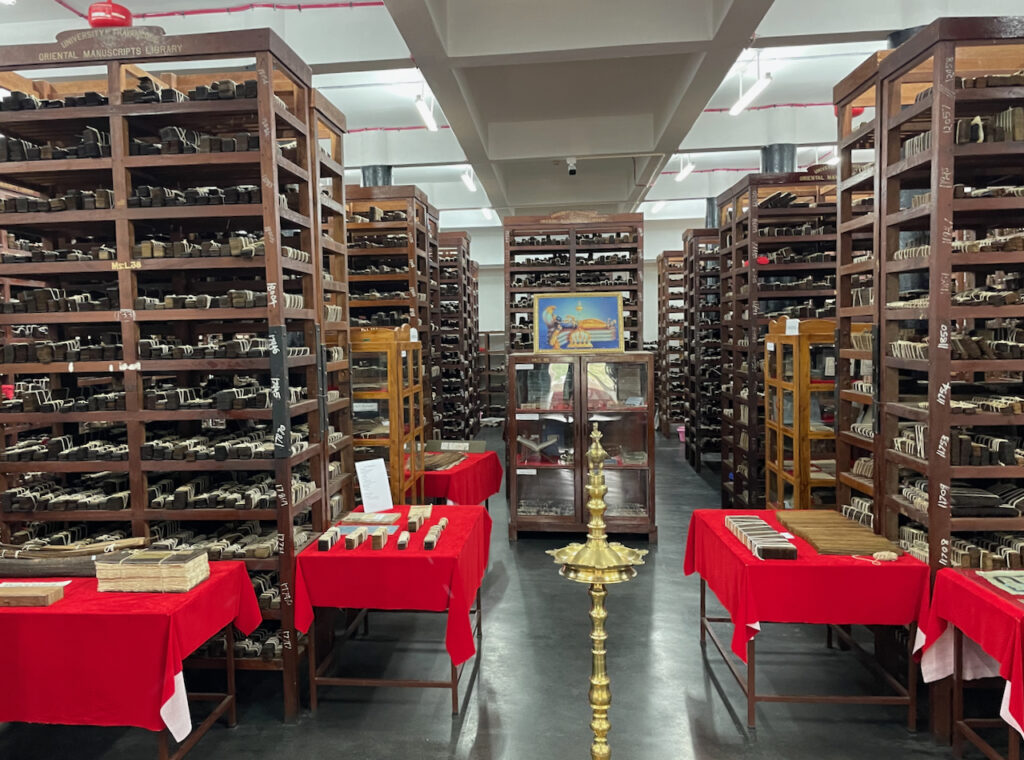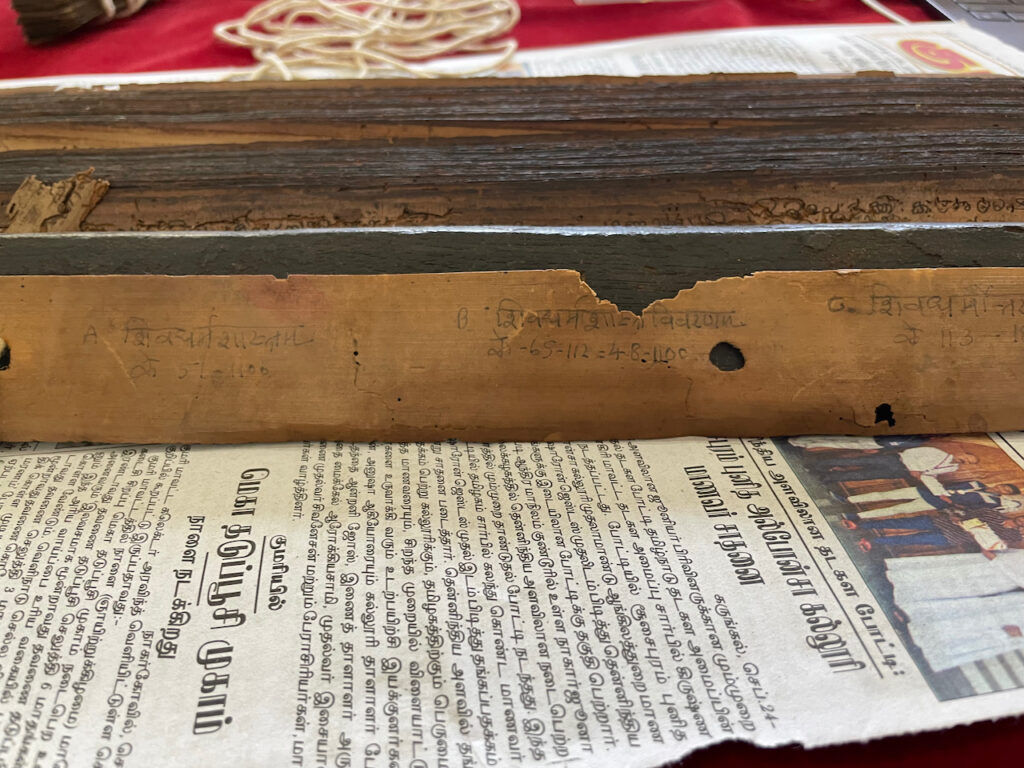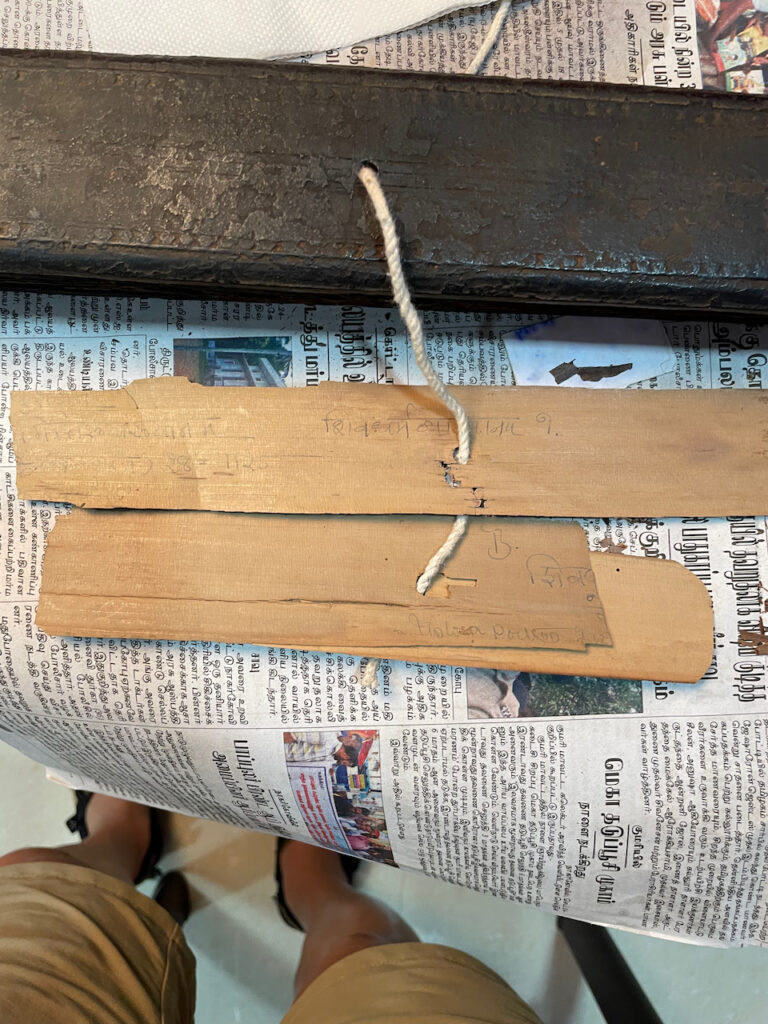From 25 to 31 January 2023, I, Kengo Harimoto, visited the Oriental Research Institute and Manuscript Library, University of Kerala, Thiruvananthapuram, Kerala.

We have known and have been reading some Śivadharma manuscripts written in the Malayalam script that is used in Kerala. The National Mission for Manuscripts’ online catalogues list a number of the Śivadharmaśāstra and the Śivadharmottara manuscripts. Those texts had apparently gained popularity and quite possibly been influential in that part of India, which is very unique in many senses, not least culturally.
We are becoming more and more aware of an intriguing part of the Śivadharma heritage, which is a pair of commentaries on the Śivadharmaśāstra and the Śivadharmottara, preserved in the Malayalam script. Bisschop, Kafle, and Lubin (A Śaiva Utopia, 2021) included a part of the commentary—on the 11th chapter of the Śivadharmaśāstra—and Florinda De Simini has been editing the beginning of the commentary on the Śivadharmottara. During our reading sessions, I have been impressed by the learnedness and intelligence of the author of the commentary. The author gives the impression that he comes from the Śāstric background. He is fluent in the vocabulary of Śaṅkara, the 8th century Advaita Vedānta philosopher, and is familiar with various śāstric discussions, such as on omniscience, the creator of the universe, language theories, and so forth. He also appears to be a skilled commentary author; when he explains certain choice of a word or the topic has a meaning, his explanation is often persuasive.
We have only known one very old manuscript of the commentary written in the Malayalam script. The manuscript has become brittle and missing many parts. We have been hoping that more manuscripts of the commentary exist, at least in Kerala.
At the end of 2022, Florinda De Simini compiled a list of potential Śivadharma manuscripts in India (as opposed to those in other countries) based on the online catalog prepared by the National Mission for Manuscripts. The list revealed that Kerala holds a great number of Śivadharma manuscripts. Among those were a few possible commentary manuscripts in Kerala. Checking those manuscripts became one of the primary tasks to perform at the ORI.
The first manuscript I asked to see at the ORI had the MS No. 12766. The Alphabetical Index of Sanskrit Manuscripts in the Oriental Research Institute and Manuscripts Library, Trivandrum, volume 3, pp. 199–200 has entries on this manuscript under three different titles: the first for the Śivadharmaśāstra as 12766A, the second the Śivadharmaśāstravivaraṇa as 12766B and the Śivadharmottaravivaraṇa as 12766C.

Upon inspection, I realized that this indeed was the one we were familiar with. Although the catalogue and the notes on the manuscript cover indicate that the bundle contains three parts, the Śivadharmaśāstra, the Śivadharmaśāstravivaraṇa and the Śivadharmottaravivaraṇa in this order, currently the manuscript has the commentary on the Śivadharmottara (Śivadharmottaravivaraṇa*) as the beginning of the bundle.

There were two more items that could be manuscripts of the Śivadharmaśāstra/Uttara commentary preserved at the ORI in the list compiled from the online catalogue. They were tracked down in the volume 7 of the Alphabetical List published in the year 2000. It was the third part of the supplementary list and this could explain why we only recently noticed their possible existence. They are also listed as the Śivadharmaśāstravivaraṇa (16349C) and the Śivadharmottaravyākhyā (17630B), coincidentally again on p. 200. Considering that those titles are conventional (they simply say either the commentary on the Śivadharmaśāstra or another on the Śivadharmottara), and since I have not seen any colophons explicitly stating whether the commentary is a vivaraṇa, a vyākhyā or any other title denoting a commentary, I thought there was a good chance that those entries may be of manuscripts of the commentary we were studying. So, I asked the helpful staff of the ORI that I consult those two manuscripts.

When those manuscripts showed up, I noticed that they were very old. They looked like as old a manuscript can be in the South Indian climate. My non-scientific estimate is somewhere around the 17th century.
I first looked at 17630. The Alphabetical List reported that the second part of the manuscript was a commentary on the Śivadharmottara. It is again a very old manuscript and the palm-leaf is so fragile that I was hesitant to turn folios because I feared damaging the manuscript. After inspecting a few folios, I realized that it was rather a commentary on the Śivadharmaśāstra. And from the little I have seen of the Śivadharmaśāstra commentary in 12766, it appears to be the same commentary. Already many parts have been lost (lost folios and broken off pieces) but this should complement what is available in 12766. I decided to order reproduction only of 12763B, the Śivadharmaśāstra commentary part of the manuscript. I hoped to minimize damage by asking to photograph only a portion.

The other manuscript that we could expect to have a commentary on the Śivadharmaṡāstra or the Śivadharmottara was 16349. This bundle too looked very old. The ORI had noted that it had three parts: the Śivadharmaśāstra (16349A), the Śivadharmottara (16349B), and the Śivadharmaśāstravivaraṇa (16349C).
It is always the case with Sanskrit manuscripts that as soon as we start looking at them, we find something interesting that was not recorded in catalogues. This was again the case with this manuscript. This manuscript is not in good condition, either. Many folios have broken into several pieces. It does not appear complete. A number of folios may very well be missing. We will have to examine how much of the text has survived in this manuscript, but it appears true that it had at least three parts: the Śivadharmaśāstra, the Śivadharmottara and a commentary. From what I could examine, it appeared that it was the same commentary on the Śivadharmaśāstra found in two more manuscripts (12766 and 17630). Unfortunately, this appears also fragmentary but it should be missing different parts and therefore with three manuscripts at hand, we should be able to recover more text of the commentary on the Śivadharmaśāstra.
In the end, I could not find any further manuscript evidence of the Śivadharmottara. Yet, since our observation so far has been that this commentary was composed by the same author as the one on the Śivadharmaśāstra and was perhaps transmitted together with the °śāstra commentary, given the situations that 17630 and 16349 are in, we might still hope that some fragments are surviving in those bundles. We still have to carefully examine those manuscripts.
While I was examining manuscripts hoping to find more manuscripts of the commentaries on the Śivadharmaśāstra and the Śivadharmottara, I started to form the impression that in Kerala, there was a tradition of transmitting the Śāstra and the Uttara alongside the commentaries—or we could even call it the commentary, singular—on both. That this happens in old manuscripts could be an indication that there was a Kerala Śivadharma corpus comprising the four (or rather three?) textual components.

